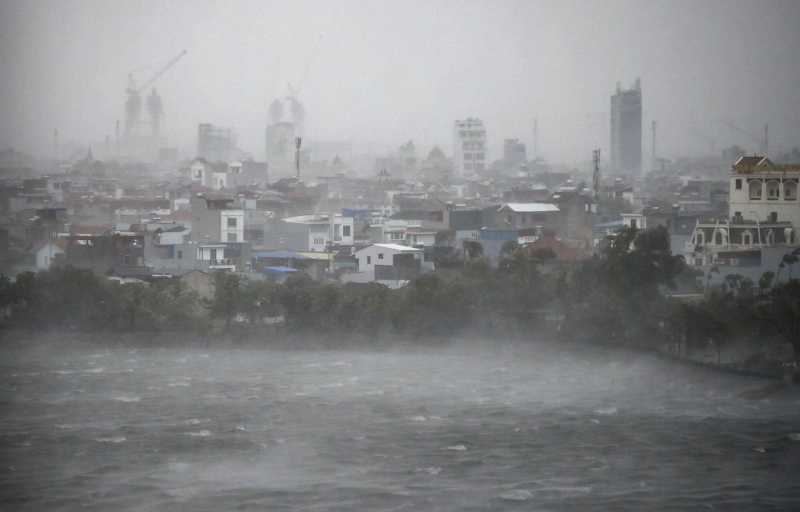
Photo: Nhac Nguyen Agence France-Presse “It's been years since I've seen a typhoon of this magnitude,” Tran Thi Hoa, a 48-year-old Haiphong resident, told AFP.
Aniruddha Ghosal – Associated Press in Hanoi, Vietnam
Published at 9:05 a.m. Updated at 2:33 p.m.
- Asia
Authorities in Vietnam said Typhoon Yagi killed at least four people and injured 78 others after making landfall in the northern part of the country on Saturday afternoon.
Yagi, described by Vietnamese weather officials as “one of the strongest typhoons in the region in the past decade,” headed toward the Southeast Asian country after killing three people and injuring nearly 100 others in China's Hainan province.
The typhoon made landfall in Vietnam’s coastal provinces of Quang Ninh and Haiphong with winds of up to 149 kilometers per hour (km/h), state media reported. Before the typhoon made landfall, strong winds tore down a tree, killing a woman in the capital, Hanoi, local media reported Saturday.
Quang Ninh province is home to the UNESCO World Heritage Site of Ha Long Bay, known for its many towering limestone islands. Hundreds of cruises were canceled to the popular site ahead of the typhoon’s landfall, according to local media. Haiphong is an industrial hub that is home to major factories including electric vehicle maker VinFast and Apple supplier Pegatron.
The typhoon also caused power outages in large parts of Quang Ninh and Thai Binh provinces.
The government had issued several warnings and people vulnerable to flooding or landslides were evacuated. Four airports were closed, including in Hanoi and Haiphong.
Authorities pruned trees in Hanoi to make them less likely to fall, but wind and rain toppled several trees and billboards in northern cities. Local media reported that many moored boats were swept away.
200% Deposit Bonus up to €3,000 180% First Deposit Bonus up to $20,000Yagi struck the Chinese city of Wenchang in Hainan province on Friday afternoon, packing winds of up to about 245 km/h near its center. Authorities said the typhoon killed three people and injured nearly 100 others in the province. It had affected more than 1.2 million people as of noon Saturday, according to the local Global Times newspaper.
Nearly 420,000 Hainan residents were relocated ahead of the typhoon's arrival. Half a million more people in Guangdong province were evacuated before Yagi made a second landfall in the province's Xuwen county on Friday night.
Read also
- Tough times for environmentalists in Vietnam
- A paradise lost in Vietnam… by humans
- Extremely powerful Typhoon Shanshan hits Japan
Meanwhile, the Haikou City Meteorological Observatory lowered its typhoon signal from red to orange on Saturday as it moved away.
Before leaving Hong Kong, Yagi forced more than 270 people to seek refuge in temporary government shelters on Friday, and more than 100 flights in the city were canceled due to the typhoon. Heavy rains and strong winds downed dozens of trees. Stock exchanges, banking services and schools also shut down.
Yagi was still a storm when it blew from the northwest Philippines into the South China Sea on Wednesday, killing at least 20 people and leaving 26 missing, mostly in landslides and widespread flooding, and affecting more than 2.3 million people in the northern and central provinces.
More than 82,200 people have been displaced from their homes in Philippine provinces. Schools, work, inter-island ferry services and domestic flights have been disrupted for days, including in the densely populated capital, Metro Manila.
Benjamin Horton, director of the Singapore Earth Observatory, said storms like Typhoon Yagi were “becoming stronger due to climate change, mainly because warmer ocean waters provide more energy to power storms, leading to increased wind speeds and heavier rainfall.”
Climate change also causes storms to potentially shift to new locations. Studies by the observatory show that the latitude where storms peak is shifting, exposing new areas to storm impacts, Horton said.
Protecting natural systems, from reefs to rivers, building structures that are more resilient to high winds and debris, and improving existing infrastructure are all steps that could help countries better cope with severe typhoons, Horton said.

